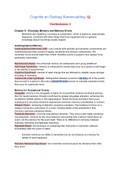Samenvatting
Alles omvattende samenvatting: Statistics
- Instelling
- Radboud Universiteit Nijmegen (RU)
This summary provides a clear description of everything discussed in the lectures, including clear examples and images from the slides. This summary discusses certain chapters from Andy Field's book in an easier way.
[Meer zien]














